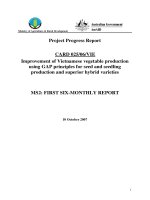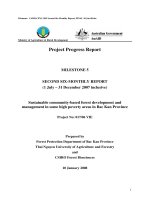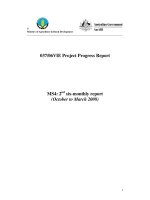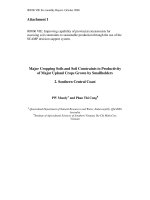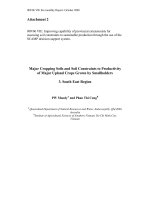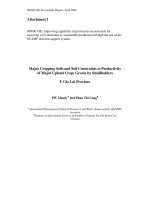Dự án nông nghiệp " Improving capability of provincial extensionists for assessing soil constraints to sustainable production through the use of the SCAMP decision support system " MS5 pptx
Bạn đang xem bản rút gọn của tài liệu. Xem và tải ngay bản đầy đủ của tài liệu tại đây (51.06 KB, 8 trang )
1
Ministry of Agriculture & Rural Development
Completion Report
009/06 VIE: Improving capability of provincial
extensionists for assessing soil constraints to
sustainable production through the use of the
SCAMP decision support system
MS 5: Completion (Fourth Six Monthly) Report
December 2009
2
Table of Contents
1. Institute Information ___________________________________________________ 3
2. Project Abstract _______________________________________________________ 4
3. Executive Summary ____________________________________________________ 4
4. Introduction & Background _____________________________________________ 5
5. Progress to Date _______________________________________________________ 6
5.1 Implementation Highlights ________________________________________________ 6
5.2 Smallholder Benefits______________________________________________________ 6
5.3 Capacity Building ________________________________________________________ 6
5.4 Publicity________________________________________________________________ 7
5.5 Project Management _____________________________________________________ 7
6. Report on Cross-Cutting Issues___________________________________________ 7
6.1 Environment ____________________________________________________________ 7
6.2 Gender and Social Issues __________________________________________________ 7
7. Implementation & Sustainability Issues ____________________________________ 7
7.1 Issues and Constraints ____________________________________________________ 7
7.2 Options_________________________________________________________________ 7
7.3 Sustainability____________________________________________________________ 7
8. Next Critical Steps _____________________________________________________ 8
9. Conclusion ___________________________________________________________ 8
3
1. Institute Information
Project Name
Improving capability of provincial extensionists for
assessing soil constraints to sustainable production
through the use of the SCAMP decision support
system.
Vietnamese Institution
Institute of Agricultural Sciences of Southern
Vietnam
Vietnamese Project Team Leader
Dr Phan Thi Cong
Australian Organisation
Queensland Department of Environment and
Resource Management (formerly Natural
Resources and Water)
Australian Personnel
Dr Philip W Moody
Date commenced
20 June 2007
Completion date (original)
May 2009
Completion date (revised)
December 2009
Reporting period
November 2008 – December 2009
Contact Officer(s)
In Australia: Team Leader
Name:
Dr PW Moody
Tel:
07 3896 9494
Position:
Principal Scientist
Fax:
07 3896 9623
Organisation
Queensland Department of
Environment and Resource
Management
In Australia: Administrative contact
Name:
Ms Melissa Coonan
Tel:
07 3896 9833
Position:
Senior Project Officer
Fax:
Organisation
Queensland Department of
Environment and Resource
Management
In Vietnam
Name:
Dr Phan Thi Cong
Tel:
+84 89104307
Position:
Head, Soil Chemistry and Soil
Fertility
Fax:
+84 8829 7650
Organisation
Institute of Agricultural Sciences
of Southern Vietnam
Email:
4
2. Project Abstract
3. Executive Summary
In the final period of the project, a training course was held in Tay Ninh from 22-24
December 2008. Thirty six extensionists attended, representing most districts in five
provinces of the South East Region. Following the first day of lectures and
demonstrations focusing on the determination and interpretation of the key soil
properties used in SCAMP, field trips were made on the second day to some sites on
different soil types. A soil pit was dug to 150 cm depth to examine the different
horizons formed during a long weathering process to form a typical Haplic Acrisol.
Soil compaction and plinthite formation are two major processes occurring in the
profile which were never thought about by these participants. IAS project staff
demonstrated how a SCAMP assessment is made. Participants were then split into
groups to undertake their own SCAMP assessments. Each group was assigned to
work at different site where their soil pit representatives for different position in the
field concerning their topography. The demonstration field experiment was also
visited, and observations made on crop growth responses to the farmer’s practice and
the SCAMP treatments. On the last day of the workshop, teams reported back their
results and these were discussed.
At the local demonstration field experiment, treatments included application of
Eupatorium odoratum (a local weed species) for assessment of its capacity in
reducing the impact of soil compaction (improving soil aeration and water infiltration
rate), and addition of a high-activity clay to increase the nutrient holding capacity of
the soil. These treatments were designed to moderate soil constraints identified from a
SCAMP assessment of the soil. Benefit/cost analysis indicated that both treatments
resulted in ratios of 1.7 and 1.6 respectively compared to 0.7 for local farmer practice
(see Attachment A).
Rural poverty reduction in Vietnam will not be achieved unless the capacity of farmers to adopt
profitable and sustainable agricultural systems is enhanced through technology and knowledge
products. In a previous ACIAR-funded project, the decision support package (‘SCAMP’- Soil
Constraints and Management Package) was developed to identify soil constraints from simple
field observation of soil features, supported by simple field and laboratory chemical analyses.
SCAMP uses several soil physical (e.g. permeability, drainage) and soil chemical (e.g. pH, EC)
properties to develop appropriate practices for nutrient management, tillage, crop rotations, and
soil erosion control. In this CARD project, SCAMP training courses were held for district and
provincial extensionists in Gia Lai , Ninh Thuan and Tay Ninh Provinces. The workshops
comprised in-field training, and field experiments in Gia Lai and Tay Ninh were used to
demonstrate how soil constraints identified in the SCAMP assessment could be addressed with
appropriate management practices. Benefit/cost analysis of these practices demonstrated the
benefits of adopting a structured approach to assessing and addressing soil constraints to
productivity. In total, 167 participants attended the workshops and responses to questionnaires
indicated that over 90% of participants would apply the knowledge and concepts presented at the
workshops to their local situation by training workshops and one-on-one interactions with farmers.
5
The pre- and post-course questionnaires identified some major changes in the
perceptions of extensionists as a result of the course. In particular, a better
understanding of the effects of specific soil properties on constraints resulted in more
specific suggestions for sustainable management practices and the recognition that
application of fertilisers was not the answer to all soil productivity problems. There
was an increased awareness of the necessity for soil-specific management based on
the inherent constraints identified for the soil. It was clearly the desire of the
extensionists to pass on their knowledge to farmers through training courses. The role
of a mobile lab to improve the identification of soil fertility constraints was seen as a
necessity.
4. Introduction & Background
Provincial extensionists provide advice to smallhold farmers on all aspects of crop
production including general agronomy and pest and disease management. Because of
the wide breadth of knowledge required to meet this demand for advice, extensionists
often do not have the depth of soil knowledge required to give soil-specific
management advice including fertiliser recommendations. The result is ‘one size fits
all’ advice on cropping and tillage management, erosion control, and the use of
organic amendments. Fertiliser recommendations follow a recipe book based on the
crop without regard to existing levels of soil fertility or soil differences in nutrient
retention and supply capacity. However, the key to sustainable and profitable
cropping is a soil-specific approach to soil management and nutrient inputs, with the
latter including assessment of all locally available organic amendments and inorganic
fertiliser forms.
The aim of this project was to provide training to extensionists to allow them to
determine key soil attributes such as colour, texture, permeability, drainage, aggregate
stability, pH and electrical conductivity and to infer key soil and fertiliser
management strategies based on these attributes. The decision support tool, SCAMP
(Soil Constraints and Management Package), was used as the framework for this
training and provided a soil-specific approach to crop management.
The objectives of this project were:
• Based on basic soil information, identify soil constraints to crop
production in the target areas of the Central Highlands, South Central
Coast and South East Regions;
• Provide site specific management guidelines for sustainable production
of focus crops on major soil groups within the target areas;
• Build technological development and knowledge application capacity
by training a network of local agricultural extensionists (provincial and
district levels) to identify soil constraints and to give recommendations
for soil management practices that underpin sustainable agricultural
development.
6
5. Progress to Date
5.1 Implementation Highlights
The project objectives were achieved by undertaking three workshops that trained 167
key provincial and district extensionists how to determine and interpret several key
soil properties. The workshops in Gia Lai and Tay Ninh were supported by
demonstration field experiments that compared treatments based on assessment of
soil-specific properties with local farmer practice. At both sites, treatments such as the
application of locally available plant amendments and high activity clay were shown
to have higher benefit cost ratios than local farmer practice. It was apparent that
greater utilisation of local available amendments and using fertiliser ‘straights’ such
as fused magnesium phosphate (FMP) rather than fertiliser blends are two
management options that often result in profitable and sustainable production.
The pre- and post-course questionnaires indicated some major shifts in the
perceptions of extensionists as a result of the workshops. In particular there was
enhanced understanding of the impacts of key soil properties such as field texture on
soil management and greater awareness of the reasons for beneficial effects of green
manure residues on soil productivity. This increased knowledge was evident in the
post-questionnaire responses where participants identified the need to manage soil-
specific constraints rather than making reference to general issues such as ‘soil
fertility’ which were common in the pre-workshop questionnaire responses.
All participants indicated their intention to train local farmers in sustainable soil
management using the SCAMP framework as the basic resource tool. It is expected
that this will lead to widespread dissemination of knowledge.
5.2 Smallholder Benefits
The end beneficiaries of this project are smallhold farmers, and the ultimate measure
of adoption will be changed management practices at the smallholder plot scale. This
change will be the result of interaction between the farmer and extensionists and
'champion' farmers who have been trained in sustainable soil management in this
project. Improved soil management will result in food security, an increase in living
standards and a farming system that is not exploitative but which maintains the
productivity of the soil resource by managing the soil within its inherent constraints.
5.3 Capacity Building
Vietnam has an effective national extension network, and this network is widely
accepted by farmers as a source of information and advice. However, agricultural
extensionists often lack a basic background in soil science making it difficult for
farmers to obtain information on sustainable soil management. It is this capacity gap
in the knowledge of extensionists that was addressed by this CARD project. The three
SCAMP training courses carried out during the project trained provincial and district
extensionists to determine field texture, pH, and EC of soils and to observe and record
properties such as position in the landscape, drainage, permeability, colour, structure
and compaction. The implications of these properties for soil management were
explained and demonstrated in the field experiments, and the participants indicated
their intention to return to their local networks and instruct others.
7
5.4 Publicity
All opportunities were taken for local TV to record segments during the training
courses and field activities, and these were aired during provincial news programs.
Articles on the project were prepared for all CARD Newsletters.
5.5 Project Management
At all times the Vietnamese project staff enthusiastically and conscientiously carried
out project activities and the operational requirements of the project were completed
on schedule. However, reporting milestones- particularly this completion report-
became overdue due to time constraints on both the Vietnamese and Australian
project leaders
6. Report on Cross-Cutting Issues
6.1 Environment
This project will have positive environmental benefits in terms of
maintenance/improvement of the ecosystem functions of the soil resource, and these
impacts, together with the financial benefits identified in the demonstration field
experiments, have been highlighted as a key outcome in project publicity.
6.2 Gender and Social Issues
It is satisfying to note that at all project workshops and training events, women
extensionists and farmers comprised a significant proportion of the participants.
7. Implementation & Sustainability Issues
7.1 Issues and Constraints
No resourcing issues or constraints arose during the project.
7.2 Options
na
7.3 Sustainability
This CARD project has resulted in a network of trained personnel in the targeted
regions, and the continuing regular contact between these personnel and the IAS
project team will minimise the risk of SCAMP not being utilised.
A very notable achievement by the Vietnamese project staff- and additional to the
contracted project activities- has been the close interaction with staff involved in
agricultural development projects of the NGO World Vision, particularly the Bac
Binh ADP. Because of the positive impact that the Bac Binh World Vision staff felt
8
the CARD project had on their ability to train local farmers, the IAS project staff ran a
dedicated SCAMP workshop in HoChiMinh City from 3-5 Jan 2007 for 14 project
managers from several World Vision ADPs throughout Vietnam.
8. Next Critical Steps
A need was been identified by extensionists for further training in the measurement
and interpretation of SCAMP level 3 attributes using a mobile lab: organic carbon,
extractable phosphorus and exchangeable potassium in addition to the SCAMP level
2 attributes of soil pH and electrical conductivity. It is apparent from discussions with
the workshop participants that the vast majority of fertiliser recommendations follow
a recipe approach based on crop type without regard for the existing soil fertility
status. This situation leads to over-application of inorganic fertilisers or unbalanced
nutrient addition. To counteract this, on-site soil analyses for organic carbon,
phosphorus and potassium are required. Methodologies exist for undertaking these
analyses rapidly in the field with a minimum of equipment. A mobile lab approach
has been adopted in both Thailand (Dr Soils Program) and the Philippines, and is used
at farmer field days to give fertiliser recommendations in conjunction with advice on
other issues such as plant disease and pest management.
It is strongly recommended that such an approach be adopted in Vietnam. SCAMP
assessment of local soils in association with a mobile lab to undertake analyses on
farmer samples has real potential for extending sustainable land management
practices throughout the country. With funding assistance from ACIAR and The
Crawford Fund, the Australian and Vietnamese project leaders are planning a soil test
interpretation workshop that will include documentation of appropriate methods for
mobile (on-site) soil analysis. A concept plan and method manual will then be
submitted to AusAID for consideration of funding support.
9. Conclusion
This project was highly successful in increasing the knowledge and awareness of
extensionists with respect to sustainable soil management. The message that such
management needs to be soil-specific and based on identified soil constraints was
clearly recognised by participants. All participants planned to train smallholders in
the use of SCAMP for identifying soil constraints.
There are several issues requiring attention and modified practices to improve the
sustainability of cropping systems in Vietnam:
• Greater utilisation of locally available organic amendments including green
manures, animal dung and weed residues;
• Potential use of regionally sourced high activity clays to improve sandy soils;
• Greater use of fertiliser straights such as fused magnesium phosphate rather
than reliance on whatever blended fertilisers are locally available;
• Assessment of current soil fertility status (pH, EC, organic C, extractable P,
exchangeable K) as the basis for fertiliser recommendations- not a recipe book
approach to crop fertilisation;
• Investigation of a mobile lab program to provide on-site soil fertility
assessment to underpin fertiliser recommendations.


